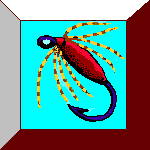


The two genera of the family Leptophlebiidae, Leptophlebia and Paraleptophlebia, are found in trout streams and are of importance to the angler. The nymphs have three tails of equal length which are longer than the body and have hair on both sides. The antennae are longer than the thorax and head combined. Bodies are not strongly flattened and display gills that are very noticeable, being either double platelike or deeply forked. Probably the best method for recognizing the adults is to study wing veination. In the fore wing, Cu2 is sharply bent and there are no long intercalary veins between M2 and Cu1. Three tails are maintained and the size range is 6 to 12 mm.

Nymphs of Paraleptophlebia have slender bodies and gills on segments 1 to 7 that are deeply forked. The head of the nymph is squarish and the middle tail is as long as, or slightly longer than, the outer ones. They are found in similar habitats to those of Leptophlebia, but can endure faster currents. Adults have slender bodies and three tails about equal in length and thickness. Often the mating flights will form over open areas away from the stream.